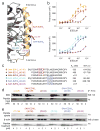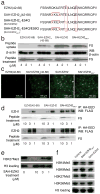Targeted disruption of the EZH2-EED complex inhibits EZH2-dependent cancer
- PMID: 23974116
- PMCID: PMC3778130
- DOI: 10.1038/nchembio.1331
Targeted disruption of the EZH2-EED complex inhibits EZH2-dependent cancer
Abstract
Enhancer of zeste homolog 2 (EZH2) is the histone lysine N-methyltransferase component of the Polycomb repressive complex 2 (PRC2), which, in conjunction with embryonic ectoderm development (EED) and suppressor of zeste 12 homolog, regulates cell lineage determination and homeostasis. Enzymatic hyperactivity has been linked to aberrant repression of tumor suppressor genes in diverse cancers. Here, we report the development of stabilized α-helix of EZH2 (SAH-EZH2) peptides that selectively inhibit H3 Lys27 trimethylation by dose-responsively disrupting the EZH2-EED complex and reducing EZH2 protein levels, a mechanism distinct from that reported for small-molecule EZH2 inhibitors targeting the enzyme catalytic domain. MLL-AF9 leukemia cells, which are dependent on PRC2, undergo growth arrest and monocyte-macrophage differentiation upon treatment with SAH-EZH2, consistent with observed changes in expression of PRC2-regulated, lineage-specific marker genes. Thus, by dissociating the EZH2-EED complex, we pharmacologically modulate an epigenetic 'writer' and suppress PRC2-dependent cancer cell growth.
Conflict of interest statement
L.D.W. is a scientific advisory board member and consultant for Aileron Therapeutics.
Figures





References
-
- Cao R. Role of Histone H3 Lysine 27 Methylation in Polycomb-Group Silencing. Science. 2002;298:1039–1043. - PubMed
-
- Czermin B, et al. Drosophila enhancer of Zeste/ESC complexes have a histone H3 methyltransferase activity that marks chromosomal Polycomb sites. Cell. 2002;111:185–196. - PubMed
-
- Müller J, et al. Histone methyltransferase activity of a Drosophila Polycomb group repressor complex. Cell. 2002;111:197–208. - PubMed
-
- Varambally S, et al. The polycomb group protein EZH2 is involved in progression of prostate cancer. Nature. 2002;419:624–629. - PubMed
Publication types
MeSH terms
Substances
Grants and funding
LinkOut - more resources
Full Text Sources
Other Literature Sources
Medical

